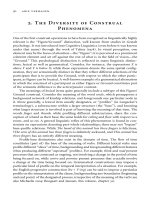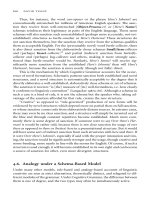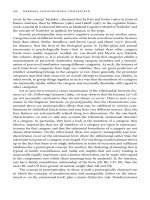Oxford American Handbook of Clinical Specialities
Bạn đang xem bản rút gọn của tài liệu. Xem và tải ngay bản đầy đủ của tài liệu tại đây (2.96 MB, 417 trang )
OXFORD ASSESS AND PROGRESS
Series Editors
Kathy Boursicot
Reader in Medical Education and Deputy Head of the Centre for
Medical and Healthcare Education,
St George’s, University of London
David Sales
Consultant in Medical Assessment
OXFORD ASSESS AND PROGRESS
Clinical
Specialties
Second Edition
Edited by
Luci Etheridge
Consultant Paediatrician and Senior Fellow in Clinical Leadership,
Barking, Havering and Redbridge University Hospitals NHS Trust
Alex Bonner
Specialist Trainee in Anaesthesia and Critical Care,
North West Deanery
3
3
Great Clarendon Street, Oxford, OX2 6DP,
United Kingdom
Oxford University Press is a department of the University of Oxford.
It furthers the University’s objective of excellence in research, scholarship,
and education by publishing worldwide. Oxford is a registered trade mark of
Oxford University Press in the UK and in certain other countries
© Oxford University Press, 2013
The moral rights of the authors have been asserted
First Edition published 2010
Second Edition published 2013
Impression: 1
All rights reserved. No part of this publication may be reproduced, stored in
a retrieval system, or transmitted, in any form or by any means, without the
prior permission in writing of Oxford University Press, or as expressly permitted
by law, by licence or under terms agreed with the appropriate reprographics
rights organization. Enquiries concerning reproduction outside the scope of the
above should be sent to the Rights Department, Oxford University Press, at the
address above
You must not circulate this work in any other form
and you must impose this same condition on any acquirer
British Library Cataloguing in Publication Data
Data available
Library of Congress Cataloging in Publication Data
Library of Congress Control Number: 2012944655
ISBN 978–0–19–965758–2
Printed in China by
C & C Offset Printing Co. Ltd
Oxford University Press makes no representation, express or implied, that the
drug dosages in this book are correct. Readers must therefore always check
the product information and clinical procedures with the most up-to-date
published product information and data sheets provided by the manufacturers
and the most recent codes of conduct and safety regulations. The authors and
the publishers do not accept responsibility or legal liability for any errors in the
text or for the misuse or misapplication of material in this work. Except where
otherwise stated, drug dosages and recommendations are for the non-pregnant
adult who is not breastfeeding
Links to third party websites are provided by Oxford in good faith and
for information only. Oxford disclaims any responsibility for the materials
contained in any third party website referenced in this work.
v
Series Editor Preface
The Oxford Assess and Progress Series is a groundbreaking development in the extensive area of self-assessment texts available for medical
students. The questions were specifically commissioned for the series,
written by practising clinicians, extensively peer-reviewed by students
and their teachers, and quality assured to ensure that the material is up to
date, accurate, and in line with modern testing formats.
The series has a number of unique features, and is designed to be as
much a formative learning resource as a self-assessment one. The questions are constructed to test the same clinical problem-solving skills that
we use as practising clinicians, rather than only to test theoretical knowledge. These skills include:
●
●
●
●
●
●
●
gathering and using data required for clinical judgement
choosing the appropriate examination and investigations, and interpretation of the findings
applying knowledge
demonstrating diagnostic skills
ability to evaluate undifferentiated material
ability to prioritize
making decisions and demonstrating a structured approach to decision
making.
Each question is bedded in reality and is typically presented as a clinical
scenario, the content of which has been chosen to reflect the common
and important conditions that most doctors are likely to encounter both
during their training and in exams! The aim of the series is to build the
reader’s confidence in recognizing important symptoms and signs and
suggesting the most appropriate investigations and management, and in
so doing to aid the development of a clear approach to patient management which can be transferred to the wards.
The content of the series has deliberately been pinned to the relevant
Oxford Handbook, but in addition has been guided by a blueprint which
reflects the themes identified in Tomorrow’s Doctors and Good Medical
Practice to include novel areas such as history taking, recognition of signs
(including red flags), and professionalism.
Particular attention has been paid to giving learning points and constructive feedback on each question, using clear fact- or evidencebased explanations as to why the correct response is right and why the
incorrect responses are less appropriate. The question editorials are
clearly referenced to the relevant sections of the accompanying Oxford
Handbook and/or more widely to medical literature or guidelines. They
are designed to guide and motivate the reader, being multi-purpose in
nature and covering, for example, exam technique, approaches to difficult subjects, and links between subjects.
vi
SERIES EDITOR PREFACE
Another unique aspect of the series is the element of competency progression from being a relatively inexperienced student to being a more
experienced junior doctor. We have suggested the following four degrees
of difficulty to reflect the level of training, so that the reader can monitor
their own progress over time:
●
●
●
●
graduate should know
graduate nice to know
foundation doctor should know
foundation doctor nice to know
We advise the reader to attempt the questions in blocks as a way of
testing their knowledge in a clinical context. The series can be treated as
a dress rehearsal for life on the ward by using the material to hone clinical acumen and build confidence by encouraging a clear, consistent, and
rational approach, proficiency in recognizing and evaluating symptoms
and signs, making a rational differential diagnosis, and suggesting appropriate investigations and management.
Adopting such an approach can aid not only success in examinations,
which really are designed to confirm learning, but also—more importantly—being a good doctor. In this way we can deliver high-quality and
safe patient care by recognizing, understanding, and treating common
problems, but at the same time remaining alert to the possibility of less
likely but potentially catastrophic conditions.
David Sales and Kathy Boursicot, Series Editors
vii
A Note on Single Best
Answer and Extended
Matching Questions
Single best answer questions are currently the format of choice
being widely used by most undergraduate and postgraduate knowledge
tests, and therefore most of the assessment questions in this book follow
this format.
Briefly, the single best answer question presents a problem, usually a
clinical scenario, before presenting the question itself and a list of five
options. These consist of one correct answer and four incorrect options
or ‘distractors’ from which the reader has to choose a response.
Extended matching questions, also known as extended matching
items, were introduced as a more reliable way of testing knowledge. They
are still widely used in many undergraduate and postgraduate knowledge
tests, and are therefore included in this book.
An extended matching question is organized as one list of possible
options followed by a set of items, usually clinical scenarios. The correct
response to each item must be chosen from the list of options.
All of the questions in this book, which are typically based on an evaluation of symptoms, signs, or results of investigations either as single entities
or in combination, are designed to test reasoning skills rather than straightforward recall of facts, and utilize cognitive processes similar to those used
in clinical practice.
The peer-reviewed questions are written and edited in accordance
with contemporary best assessment practice, and their content has been
guided by a blueprint pinned to all areas of Good Medical Practice, which
ensures comprehensive coverage.
The answers and their rationales are evidence-based and have been
reviewed to ensure that they are absolutely correct. Incorrect options
are selected as being plausible, and indeed they may appear correct to
the less knowledgeable reader. When answering questions, the reader
may wish to use the ‘cover’ test in which they read the scenario and the
question but cover the options.
Kathy Boursicot and David Sales, Series Editors
This page intentionally left blank
ix
Preface to the
Second Edition
During the journey through medical school as a student, you experience
medicine in a range of settings, from the rural general practice to the
inner-city teaching hospital. You encounter doctors working in a wide
range of specialties, many of which will be appealing future career choices
and many of which will seem daunting. Specialty attachments may be the
first time that you encounter people with mental illness, or children, or
pregnant women. Trying to absorb all of these new experiences while
also continuing to work towards final examinations can seem like a rollercoaster ride to some!
In partnership with the well-established Oxford Handbook of Clinical
Specialties, the Oxford Assess and Progress Clinical Specialties volume seeks
to tie together the clinical specialties and to provide a grounding in knowledge that may get pushed to the back burner when medicine and surgery
have to be revised. This second edition has been produced in line with
the new edition of the Oxford Handbook of Clinical Specialties, and builds
on the success of the first book, bringing you questions on the latest hot
topics, current issues, and core material. The questions in each chapter
have been written by experienced doctors working within the specialty,
who are familiar with the common presentations, pathologies, and dilemmas that are encountered. Their knowledge of teaching medical students
about their specialty, often within the confines of very short attachments,
has been transferred to these pages. All of the questions map on to medical school curricula and are rooted in real-life clinical encounters. The
grading system allows you to judge for yourself which knowledge is core
and which might require some further reading. We have added many
new guidelines and key websites to guide this reading, and we hope that
you will find these useful. The strong focus on clinical experiences also
allows you to look forward to and prepare for your time as a foundation
doctor.
We hope that, as a result of working through these questions, your
interest in and appreciation and understanding of the different clinical
specialties will grow, and you will have a useful tool for judging your own
learning needs.
Luci Etheridge and Alex Bonner
This page intentionally left blank
xi
Acknowledgements
The editors would like to thank all of the contributors for their hard
work in combining their specialist knowledge with clinical experience
to provide this resource of stimulating, realistic questions with considered explanations. Thank you also to all of the reviewers—students and
specialists—for your much valued feedback. We hope that we have managed to address your suggestions in this new edition. Finally, heartfelt
thanks to our partners—to Aaron Cue, for his support during a period
of new additions to the family, and Amy Bonner, for tolerating the editing
process, much of which occurred while living and working in Uganda.
This page intentionally left blank
xiii
Figure Acknowledgements
For Figures 2.1 and 2.6 and all of the figures in Chapter 7 on dermatology,
we are grateful to Barts and the London NHS Trust for permission to
reproduce their images, and to all of the patients who gave consent for
images to be used.
Reproduced with permission from Oxford University Press: Plate
2.5: Collier et al, Oxford Handbook of Clinical Specialties, 9th edn, p. 132,
Figure 1; Plate 4.1: Sundaram et al, Training in Ophthalmology, Figure 4.27;
Plate 4.2: Sundaram et al, Training in Ophthalmology, Figure 7.19; Plate 4.3:
Sundaram et al, Training in Ophthalmology, Figure 9.15; Plate 4.4: Sundaram
et al, Training in Ophthalmology, Figure 5.51; Plate 4.5: Sundaram et al,
Training in Ophthalmology, Figure 10.8; Plate 4.6: Sundaram et al., Training
in Ophthalmology, Figure 1.82; Plate 8.1: Hurley et al, Oxford Handbook for
the Foundation Programme, 2nd edn, p. 187, Figure 5.
The Glasgow Coma Scale on pages 271 and 341 is reproduced
from Teasdale G and Jennet B, ‘Assessment of Coma and Impaired
Consciousness: A Practical Scale’, The Lancet, Vol. 304, 1974, with permission from Elsevier.
Finally, many thanks to all of the contributors who supplied images, and
to their patients who gave consent for the images to be used.
This page intentionally left blank
xv
Contents
About the editors xvii
Contributors xix
Normal and average values xxi
Abbreviations xxxi
How to use this book xxxv
1 Obstetrics and gynaecology, and
genitourinary medicine
2 Paediatrics
3 Psychiatry
4 Ophthalmology
5 Primary care
6 ENT
7 Dermatology
8 Anaesthesia and intensive care
9 Trauma and orthopaedics
10 Emergency medicine
Index 347
1
41
95
141
155
189
221
253
283
317
This page intentionally left blank
xvii
About the Editors
Volume Editors
Luci Etheridge is a Consultant Paediatrician and Senior Fellow in Clinical
Leadership at Barking, Havering and Redbridge University Hospitals NHS
Trust in East London. She previously worked for four years with UCL
Medical School, and was involved with the development of Fitness to
Practise assessments for the General Medical Council and item writing
for the Professional and Linguistics Assessments Board Part 1 and the
Royal College of Paediatrics and Child Health. She is currently completing a doctorate in education at the Institute of Education, University of
London.
Alex Bonner is a Senior Anaesthetic Trainee in the North West
Deanery. He is regularly involved in the teaching of medical students,
foundation doctors, and anaesthetic trainees who are preparing for
their FRCA examinations. He is an instructor for Adult and Paediatric
Advanced Life Support Courses, and has experience of practising anaesthesia and teaching in sub-Saharan Africa. He has also contributed to the
development of Fitness to Practise assessments for the General Medical
Council.
Series Editors
Katharine Boursicot is a Reader in Medical Education and Deputy
Head of the Centre for Medical and Healthcare Education at St George’s,
University of London. Previously she was Head of Assessment at Barts
and the London NHS Trust, and Associate Dean for Assessment at
Cambridge University School of Clinical Medicine. She is consultant on
assessment to several UK medical schools, medical Royal Colleges, and
international institutions, as well as a consultant on the General Medical
Council Professional and Linguistic Assessments Board Part 2 Panel and
Fitness to Practise clinical skills testing.
David Sales is a general practitioner by training who has been involved
in medical assessment for over 20 years, having previously been convenor
of the MRCGP knowledge test. He has run item-writing workshops for
a number of undergraduate medical schools and medical Royal Colleges,
and internationally. He currently chairs the Professional and Linguistic
Assessments Board Part 1 panel for the General Medical Council, and is
their consultant on Fitness to Practise knowledge testing.
This page intentionally left blank
xix
Contributors
Dr Erica Allason-Jones
Mr Nev Davies
NHS consultant in Genitourinary
Medicine, Mortimer Market
Centre (Camden PCT),
London, UK
Consultant in Trauma and
Orthopaedics, Royal Berkshire
Hospital, Reading, UK
Professor Dinesh Bhugra
Registrar in Anaesthesia and
Intensive Care, Trent Region, UK
Professor of Mental Health
and Cultural Diversity at the
Institute of Psychiatry, King’s
College, London, and Honorary
Consultant, Maudsley Hospital,
London, UK
Dr James Dawson
Dr Philippa Edwards
Salaried General Practitioner,
Portsmouth, UK
Dr Luci Etheridge
Consultant in Neonatal Medicine,
Luton and Dunstable NHS
Foundation Hospital Trust,
Luton, UK
Consultant Paediatrician
and Senior Fellow in Clinical
Leadership, Barking, Havering and
Redbridge University Hospitals
NHS Trust, London, UK
Dr Alex Bonner
Dr Kamila Hawthorne
Dr Jennifer Birch
Specialist Trainee in Anaesthesia
and Critical Care, North West
Deanery, UK
Dr Ruth Brown
Consultant in Emergency
Medicine, St Mary’s Hospital,
Imperial College NHS Trust,
and Honorary Senior Lecturer,
Imperial College London, UK
General Practice Principal
in Cardiff, and Sub Dean for
Assessment, School of Medicine,
Cardiff University, Cardiff, UK
Mr Kevin Hayes
Senior Lecturer and Consultant in
Obstetrics and Gynaecology,
St George’s Hospital, London, UK
Dr Virginia Hubbard
Clinical Lecturer and Sub-Dean
E-learning, UCL Medical School,
London, UK, and salaried General
Practitioner
Consultant Dermatologist,
Homerton University Hospital,
and Clinical Senior Lecturer,
Barts and the London School of
Medicine and Dentistry, UK
Dr Jonathan Darling
Dr Vikram Jha
Dr Will Coppola
Senior Lecturer in Paediatrics
and Child Health, University of
Leeds, and Honorary Consultant
Paediatrician, Leeds Teaching
Hospitals NHS Trust, Leeds, UK
Senior Lecturer in Medical
Education, Leeds Institute of
Medical Education, University of
Leeds, and Honorary Consultant
Obstetrician, Bradford Teaching
Hospitals NHS Trust, UK
xx
CONTRIBUTORS
Dr Gill McGauley
Dr Zeryab Setna
Reader in Forensic Psychotherapy,
St George’s University of London,
and Consultant in Forensic
Psychotherapy, Broadmoor
Hospital, West London Mental
Health NHS Trust, UK
Research Fellow in Medical
Education, Leeds Institute of
Medical Education, University of
Leeds, Leeds, UK
Dr Isabel McMullen
Specialty Registrar in Psychiatry,
South London and Maudsley NHS
Foundation Trust, UK
Dr Matthew Mathai
Consultant Paediatrician, Bradford
Royal Infirmary, and Honorary
Lecturer in Paediatrics and Child
Health, University of Leeds, UK
Mr Venki Sundaram
Specialty Registrar in
Ophthalmology, London Deanery,
London, UK
Miss Philippa Tostevin
Senior Lecturer in Surgical
Education, St George’s University
of London, and Honorary
Consultant Otolaryngologist,
St George’s Hospital,
London, UK
xxi
Normal and Average
Values
Biochemistry: reference intervals
All laboratory discourse is probabilistic. Drugs may interfere with any
chemical method; as these effects may be method dependent, it is difficult
for us to be aware of all of the possibilities. If in doubt, discuss the issue
with the laboratory.
Substance
Specimen
Normal value
Adrenocorticotrophic
hormone
P
< 80 ng/L
Alanine aminotransferase
P
5–35 IU/L
Albumin
P†
35–50 g/L
Aldosterone
P*
100–500 pmol/L
Alkaline phosphatase
P†
30–150 IU/L (adults)
D-fetoprotein
S
< 10 kU/L
D-amylase
P
0–180 Somogyi units/dL
Angiotensin II
P*
5–35 pmol/L
Antidiuretic hormone
P
0.9–4.6 pmol/L
Aspartate transaminase
P
5–35 IU/L
E-HCG
S
M: < 10 mIU/mL; F (nonpregnant): < 25 mIU/mL;
F (4 weeks pregnant): > 1000
mIU/mL
Bicarbonate
P†
24–30 mmol/L
Bilirubin
P
3–17 μmol/L (0.25–1.5 mg/100
mL)
Calcitonin
P
< 0.1 micrograms/L
Calcium (ionized)
P
1.0–1.25 mmol/L
Calcium (total)
P†
2.12–2.65 mmol/L
Chloride
P
95–105 mmol/L
xxii
NORMAL AND AVERAGE VALUES
Substance
Specimen
Normal value
Cholesterol‡
P
3.9–7.8 mmol/L
VLDL
P
0.128–0.645 mmol/L
LDL
P
1.55–4.4 mmol/L
HDL
P
0.9–1.93 mmol/L
Cortisol
P
a.m.: 450–700 nmol/L; midnight:
80–280 nmol/L
C-reactive protein (CRP)
S
< 10 mg/L
Creatine kinase
P
M: 25–195 IU/L; F:25–170 IU/L
Creatinine (related to
lean body mass)
P†
70–≤150 μmol/L
CSF glucose
CSF
> 2/3 of blood range
CSF protein
CSF
< 40 mg/dL
CSF white cells
CSF
< 5/mm3
Ferritin
P
12–200 micrograms/L
Folate
S
2.1 micrograms/L
Follicle-stimulating
hormone (FSH)
P/S
Luteal: 2–8 U/L
Ovulatory peak: 8–15 U/L
Follicular phase, and M: 0.5–5 U/L
Post-menopausal: < 30 U/L
Gamma-glutamyl
transpeptidase
P
M: 11–51 IU/L; F: 7–33 IU/L
Glucose (fasting)
P
3.5–5 mmol/L
Glycated (glycosylated)
haemoglobin
B
5–8%
Growth hormone
P
< 20 mU/L
Iron
S
M: 14–31 μmol/L;
F: 11–30 μmol/L
Lactate dehydrogenase
(LDH)
P
70–250 IU/L
Lead
B
< 1.8 mmol/L
Luteinizing hormone
P/S
Premenopausal: 3–13 U/L
Follicular: 3–12 U/L
Ovulatory peak: 20–80 U/L
Luteal: 3–16 U/L
Post-menopausal: < 30 U/L
Magnesium
P
0.75–1.05 mmol/L
Osmolality
P
278–305 mosmol/kg
Parathyroid hormone
(PTH)
P
< 0.8–8.5 pmol/L
Phosphate (inorganic)
P
0.8–1.45 mmol/L
NORMAL AND AVERAGE VALUES
Substance
Specimen
Normal value
Potassium
P
3.5–5.0 mmol/L
Prolactin
P
M: < 450 U/L; F: < 600 U/L
Prostate-specific antigen
P
0–4 ng/mL
Protein (total)
P
60–80 g/L
Red cell folate
B
0.36–1.44 μmol/L
(160–640 micrograms/L)
Renin (erect/recumbent)
P*
2.8–4.5/1.1–2.7 pmol/mL/hour
Sodium
P†
135–145 mmol/L
Thyroid-binding globulin
(TBG)
P
7–17 mg/L
Thyroid-stimulating
hormone (TSH) (normal
range widens with age)
P
0.5–5.7 mU/L
Thyroxine (T4)
P
70–140 nmol/L
Thyroxine (free)
P
9–22 pmol/L
Total iron-binding capacity
S
54–75 μmol/L
Triglyceride
P
0.55–1.90 mmol/L
Tri-iodothyronine
P
1.2–3.0 nmol/L
Urea
P†
2.5–6.7 mmol/L
Urate
P†
M: 210–480 μmol/L;
F: 150–390 μmol/L
Vitamin B12
S
0.13–0.68 nmol/L (< 150 ng/L)
* The sample requires special handling. Contact the laboratory.
†
Range is significantly different in pregnancy (see below).
‡
Desired upper limit of cholesterol level would be < 5 mmol/L.
Abbreviations: P, plasma (heparin bottle); S, serum (clotted; no anticoagulant); B, whole
blood (edetic acid (EDTA) bottle); CSF, cerebrospinal fluid specimen; IU, International Unit;
M, males; F, females; HDL, high-density lipoprotein; LDL, low-density lipoprotein; VLDL,
very-low-density lipoprotein.
Arterial blood gases
pH
7.35–7.45
PaCO2
4.7–6.0 kPa
PaO2
< 10.6 kPa
Base excess
±2 mmol/L
Note: 7.6 mmHg = 1 kPa (atmospheric
pressure ≈ 100 kPa).
xxiii
xxiv
NORMAL AND AVERAGE VALUES
Haematology: reference intervals
Measurement
Reference interval
White cell count (WCC)
4.0–11.0 × 109/L
Red cell count
M: 4.5–6.5 × 1012/L; F: 3.9–5.6 × 1012/L
Haemoglobin
M: 13.5–18.0 g/dL; F: 11.5–16.0 g/dL
Packed red cell volume (PCV)
or haematocrit
M: 0.4–0.54 I/L; F: 0.37–0.47 I/L
Mean cell volume (MCV)
76–96 fL
Mean cell haemoglobin (MCH)
27–32 pg
Mean cell haemoglobin
concentration (MCHC)
30–36 g/dL
Neutrophil count
2.0–7.5 × 109/L; 40–75% WCC
Lymphocyte count
1.3–3.5 × 109/L; 20–45% WCC
Eosinophil count
0.04–0.44 × 109/L; 1–6% WCC
Basophil count
0.0–0.1 × 109/L; 0–1% WCC
Monocyte count
0.2–0.8 × 109/L; 2–10% WCC
Platelet count
150–400 × 109/L
Reticulocyte count
25–100 × 109/L; 0.8–2.0%
Erythrocyte sedimentation rate
< 20 mm/hour (but depends on age; see
OHCM 7th edn, p. 356)
Activated partial thromboplastin
time (VIII, IX, XI, XII)
35–45 seconds
Prothrombin time
10–14 seconds
International normalized
ratio (INR)
Clinical state (see OHCM, pp. 334–5)
2.0–3.0
Treatment of deep vein thrombosis (DVT),
pulmonary emboli (treat for 3–6 months)
2.5–3.5
Embolism prophylaxis in atrial fibrillation (see
OHCM, p. 335)
3.0–4.5
Recurrent DVT and pulmonary embolism;
arterial disease including myocardial infarction;
arterial grafts; cardiac prosthetic valves (if
caged ball, aim for 4–4.9) and grafts









